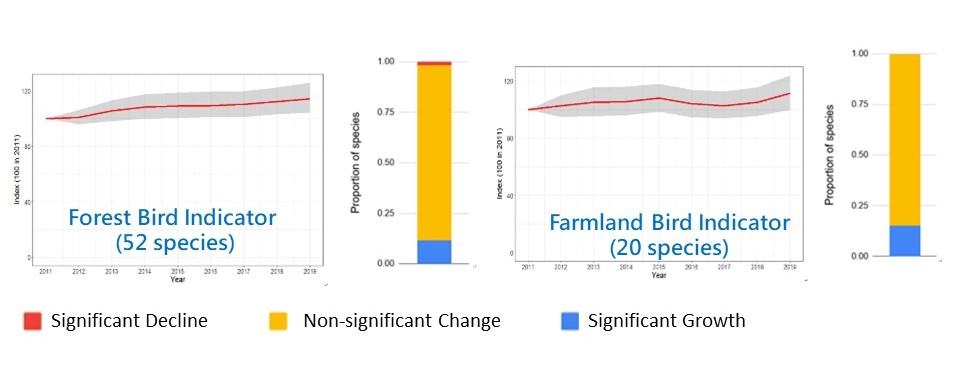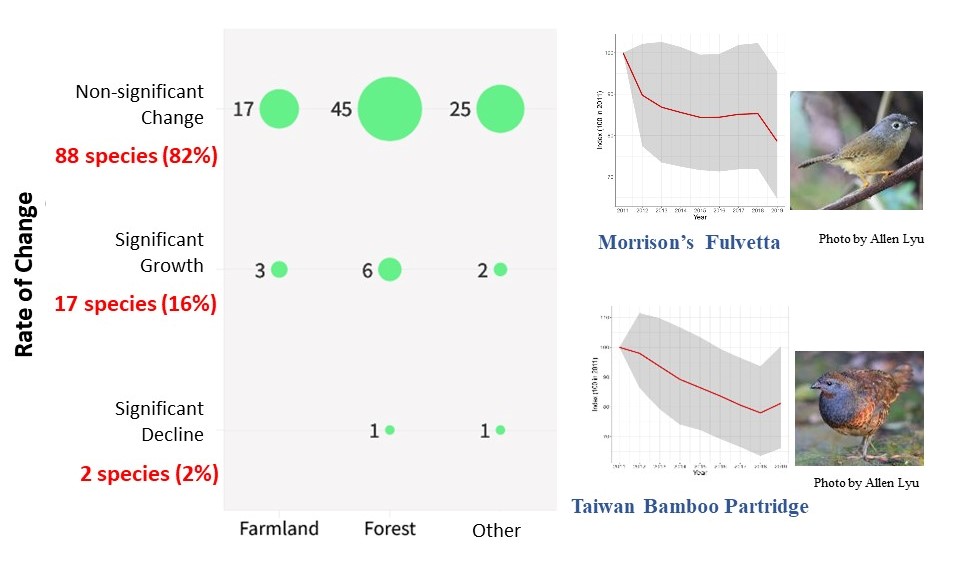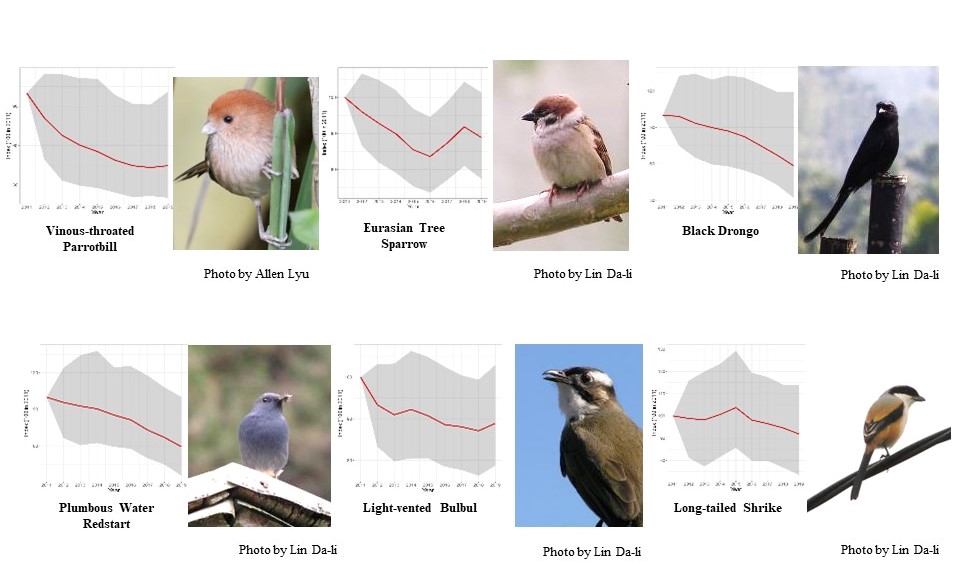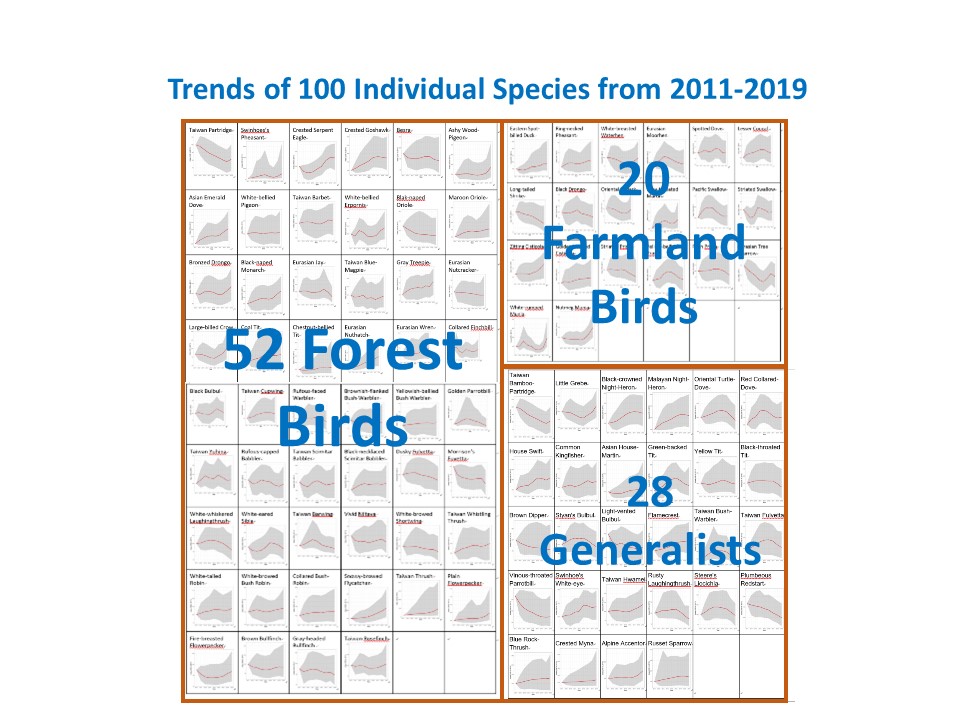Taiwan Becomes Second Country in Asia to Have National Bird Indicators for Biodiversity
-
The Taiwan Endemic Species Research Institute analyzed data collected from the Taiwan Breeding Bird Survey from 2011-2019 to understand trends for 100 breeding bird species.
-
Based on the TESRI analysis two national indicators for birds were created, one for forest birds and one for farmland birds.
-
Taiwan now becomes the second country in Asia to have composite species indicators for biodiversity.
-
Work reflects Taiwan’s adherence to UN Convention on Biological Diversity's Kunming-Montreal Global Biodiversity Framework.
-
Research has been published in journal Ecological Indicators.
The Taiwan Endemic Species Research Institute (TESRI) under the Council of Agriculture, Executive Yuan analyzed data from the Taiwan Breeding Bird Survey to understand population trends for 100 species of breeding birds during the period of 2011 to 2019. In doing so, two national indicators for birds were established, one for Taiwan's forest birds and one for Taiwan's farmland birds. Using this study as a baseline, trends and indicators will be updated regularly and are anticipated to serve as an important dashboard for monitoring the survival status and effectiveness of conservation efforts for Taiwan's breeding birds. At the same time, this work also reflects Taiwan's adherence to the United Nations Convention on Biological Diversity's goal of Nature-Positive by 2030. In publishing this work, Taiwan becomes just the second country in Asia to craft composite species indicators for biodiversity.
Towards Becoming Nature-Positive by 2030
In 2022, the 15th Conference of Parties to the United Nations Convention on Biological Diversity was held in Kunming, China and Montreal, Canada. One of the core tenets to come out of these meetings was the global goal of the earth becoming Nature-Positive by 2030 to reverse the trend of global biodiversity degradation. Furthermore, biodiversity indicators were mentioned as an important tool for gauging the changing status and trends of global biodiversity. However, in many areas, target indicators and paths to those targets remain unclear, with some still having no indicators at all. This was one of the major reasons for the global community's difficulty in achieving the goals of the Aichi Biodiversity Targets which were established in 2011. Prior to 2020, there were just 254 composite species indicators globally. These were mainly concentrated in Europe (211) with Asia having none. This changed in 2020 when India published its own national bird indicators, making it the first Asian country to do so.
Second in Asia: Taiwan's National Bird Indicators
The Taiwan Breeding Bird Survey (BBS Taiwan) is a citizen science project which looks to understand the status and trends of birds with breeding populations in Taiwan. It is a collaborative partnership between the Taiwan Endemic Species Research Institute, National Taiwan University, and the Taiwan Wild Bird Federation. Beginning in 2009, each year from March to June, hundreds of volunteers across the country help conduct surveys for breeding birds. In a report recently published in the international journal Ecological Indicators, data collected between 2011 to 2019 was analyzed to look for population trends covering 100 species of breeding bird in Taiwan. Through this work, two national composite species indicators were established: (1) Taiwan forest bird indicators (52 species), (2) Taiwan farmland bird indicators (20 species). Both sets of indicators point to gradual increases in population numbers with further analysis showing that forest and farmland environments have remained stable over time. However, more frequent disturbances to farmland environments were noted.
Analysis of the BBS Taiwan data provided many new insights for researchers. For 11 species, numbers increased significantly from 2011-2019. Meanwhile, for 87 species no significant change took place. Two breeding bird species did experience significant declines during the period, the Taiwan Bamboo Partridge and Morrison's Fulvetta. Both are endemic birds in Taiwan and the reasons behind their population declines need to be explored further. However, trends for six species barely passed the threshold for being safe. These included the Light-vented Bulbul, Eurasian Tree Sparrow, Long-tailed Shrike, Black Drongo, Vinous-throated Parrotbill, and Plumbous Water Redstart. These species are all quite different, with two being considered common, two carnivorous, and two having distinct habitat preferences, one for grasslands and one for streams. Should current trends continue they would be added to the list of species experiencing significant declines. Therefore, regardless of the current analysis results, these species also require urgent attention.
Creating A National Conservation Indicator System that is Regularly Updated
The two bird indicators will serve as national conservation indicators and be used to reflect current environmental conditions in Taiwan. Going forward, they will be regularly updated and presented in future State of Taiwan's Birds reports as part of the section dedicated to reviewing the status of Taiwan's breeding birds. Now that this trend analysis has been completed and indicator system established, researchers will next move to build indicators for the country's national parks. An attempt is also underway to use amphibian records to establish national amphibian indicators for Taiwan. It is anticipated that via having multiple types of biodiversity indicators, Taiwan's environmental situation and quality can be better understood. This will hopefully lead to earlier detection of ecological issues and subsequent improvements to address them.
For more information, please contact:
Mr. Lin Da-li, Taiwan Endemic Species Research Institute, 049-2761331, ext. 252, +886-911200033

Newly created Forest Bird Indicator and Farmland Bird Indicator. TESRI (Created by Lin Da-li)

Population trends of 100 breeding bird species in Taiwan. TESRI (Created by Lin Da-li)

Bird species with decreasing population trends whose numbers are nearing a significance threshold. TESRI (Created by Lin Da-li)

Population trends of 100 breeding bird species during the period of 2011 to 2019. TESRI (Created by Lin Da-li)
Study report avbailable here.
Cover photo: Vinous-throated Parrotbill (Credit TWBF)
